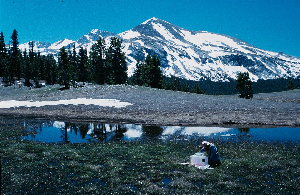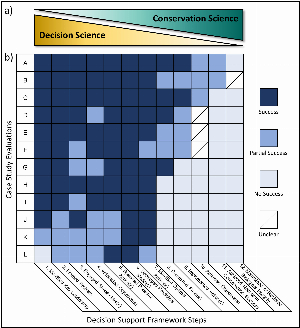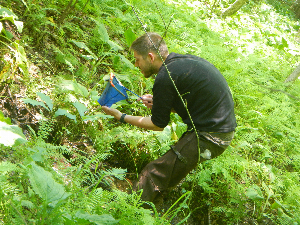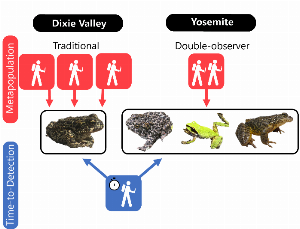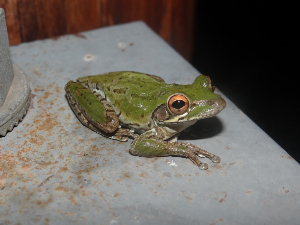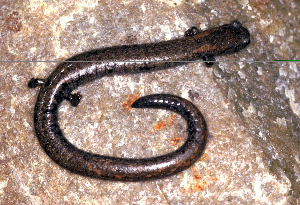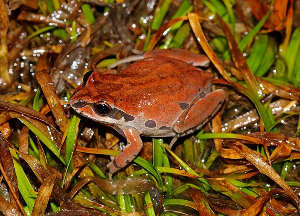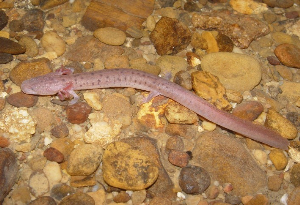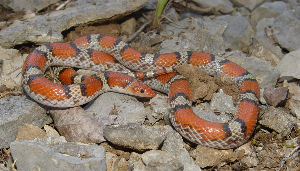Search ARMI Database
Search term(s)
Contribution Number
Search Results
879 record(s) found.
Papers & Reports Effects of experimental warming and nutrient enrichment on wetland communities at the Arctic’s edge
Authors: J M Davenport; L Fishback; Blake R Hossack
Date: 2020-09 | Outlet: Hydrobiologia
The disproportionate effects of warming for high-latitude, freshwater ecosystems has been well documented, but in some areas, changes have been further impacted by human-subsidized increases of waterfowl. To gain insight into how predicted changes in temperature and nutrient inputs might affect ecosystem function, we conducted a mesocosm experiment in the Canadian Subarctic with three levels of simulated goose enrichment and warming to measure changes in size and survival of larval wood frogs and boreal chorus frogs and primary productivity (phytoplankton and periphyton biomass). Our results highlight that the consequences of these rapid changes are non-linear and even non-intuitive, with species-specific consumer and ecosystem responses that depend on the magnitude of temperature and nutrient changes as well as community composition.
Papers & Reports Climate’s cascading effects on disease, predation, and hatching success in Anaxyrus canorus, the threatened Yosemite toad
Authors: Walt J Sadinski; A L Gallant; J Cleaver
Date: 2020-09-01 | Outlet: Global Ecology and Conservation
The U.S. Fish and Wildlife Service listed Anaxyrus canorus, the Yosemite toad, as federally threatened in 2014 based upon reported population declines and vulnerability to global-change factors. A. canorus lives only in California’s central Sierra Nevada at medium to sub-alpine elevations. Lands throughout its range are protected from development, but climate and other global-change factors potentially can limit populations. A. canorus reproduces in ultra-shallow wetlands that typically hydrate seasonally via melting of the winter snowpack. Lesser snowpacks in drier years can render wetland water volumes and hydroperiods insufficient to allow for successful breeding and reproduction. Additionally, breeding and embryogenesis occur very soon after wetlands thaw when overnight temperatures can be below freezing. Diseases, such as chytridiomycosis, which recently decimated regional populations of ranid species, also might cause declines of A. canorus populations. However, reported studies focused on whether climate interacts with any pathogens to affect fitness in A. canorus have been scarce. We investigated effects of these factors on A. canorus near Tioga Pass from 1996 to 2001. We found breeding subpopulations were distributed widely but inconsistently among potentially suitable wetlands and frequently consisted of small numbers of adults. We occasionally observed small but not alarming numbers of dead adults at breeding sites. In contrast, embryo mortality often was notably high, with the majority of embryos dead in some egg masses while mortality among coincidental Pseudacris regilla (Pacific treefrog) embryos in deeper water was lower. After sampling and experimentation, we concluded that freezing killed A. canorus embryos, especially near the tops of egg masses, which enabled Saprolegnia diclina (a water mold [Oomycota]) to infect and then spread through egg masses and kill more embryos, often in conjunction with predatory flatworms (Turbellaria spp.). We also concluded exposure to ultraviolet-B radiation did not play a role. Based upon our assessments of daily minimum temperatures recorded around snow-off during years before and after our field study, the freezing potential we observed at field sites during embryogenesis might have been commonplace beyond the years of our field study. However, interactions among snow quantity, the timing of snow-off, and coincidental air temperatures that determine such freezing potential make projections of future conditions highly uncertain, despite overall warming trends. Our results describe important effects from ongoing threats to the fitness and abundance of A. canorus via reduced reproduction success and demonstrate how climate conditions can exacerbate effects from pathogens to threaten the persistence of amphibian populations.
Papers & Reports Moving from decision to action in conservation science
Authors: Alexander D Wright; Riley F Bernard; Brittany A Mosher; Katherine M O'Donnell; Taylor Braunagel; Graziella V DiRenzo; Jill Fleming; C Shafer; Adrianne B Brand; E F Zipkin; Evan HC Grant
Date: 2020 | Outlet: Biological Conservation
Biodiversity loss is a major threat to the integrity of ecosystems and is projected to
worsen, yet the path to successful conservation remains elusive. Decision support
frameworks (DSFs) are increasingly applied by resource managers to navigate the
complexity, uncertainty, and differing socio-ecological objectives inherent to
conservation problems. Most published conservation research that uses DSFs focuses
on analytical stages (e.g., identifying an optimal decision), making it difficult to assess
and learn from previous examples in a conservation practice context. Here, we (1)
evaluate the relationship between the application of decision science and the resulting
conservation outcomes, and (2) identify and address existing barriers to the application
of DSFs to conservation practice. To do this, we develop a framework for evaluating
conservation initiatives using decision science that emphasizes setting attainable
goals, building momentum, and obtaining partner buy-in. We apply this framework to a
systematic review of amphibian conservation decision support projects, including a
follow-up survey of the pertinent conservation practitioners, stakeholders, and
scientists. We found that all projects identified optimal solutions to reach stated
objectives, but positive conservation outcomes were limited when implementation
challenges arose. Further, we identified multiple barriers (e.g., dynamic and
hierarchical leadership, scale complexity, limited resource availability) that can inhibit
the progression from decision identification to action implementation (i.e., ‘decision-implementation gap’), and to successful conservation outcomes. Based on these results, we provide potential actionable steps and avenues for future development of DSFs to facilitate the transition from decision to action and the realization of conservation successes.
worsen, yet the path to successful conservation remains elusive. Decision support
frameworks (DSFs) are increasingly applied by resource managers to navigate the
complexity, uncertainty, and differing socio-ecological objectives inherent to
conservation problems. Most published conservation research that uses DSFs focuses
on analytical stages (e.g., identifying an optimal decision), making it difficult to assess
and learn from previous examples in a conservation practice context. Here, we (1)
evaluate the relationship between the application of decision science and the resulting
conservation outcomes, and (2) identify and address existing barriers to the application
of DSFs to conservation practice. To do this, we develop a framework for evaluating
conservation initiatives using decision science that emphasizes setting attainable
goals, building momentum, and obtaining partner buy-in. We apply this framework to a
systematic review of amphibian conservation decision support projects, including a
follow-up survey of the pertinent conservation practitioners, stakeholders, and
scientists. We found that all projects identified optimal solutions to reach stated
objectives, but positive conservation outcomes were limited when implementation
challenges arose. Further, we identified multiple barriers (e.g., dynamic and
hierarchical leadership, scale complexity, limited resource availability) that can inhibit
the progression from decision identification to action implementation (i.e., ‘decision-implementation gap’), and to successful conservation outcomes. Based on these results, we provide potential actionable steps and avenues for future development of DSFs to facilitate the transition from decision to action and the realization of conservation successes.
Papers & Reports Determinants and consequences of dispersal in vertebrates with complex life cycles: a review of pond-breeding amphibians
Authors: Hugo Cayuela; Andrés Valenzuela-Sánchez; L Teulier; Iñigo Martinez-Solano; Jean-Paul Lena; J Merila; Erin Muths; Richard Shine; L Quay; M Denoel; Jean Clobert; Benedikt R Schmidt
Date: 2020-02 | Outlet: The Quarterly Review of Biology
Dispersal is a central process in ecology and evolution. It strongly influences the dynamics of spatially structured populations and affects evolutionary processes by shaping patterns of gene flow. For these reasons, dispersal has received considerable attention from ecologists, evolutionary biologists, and conservationists. However, although it has been studied extensively in taxa such as birds and mammals, much less is known about dispersal in vertebrates with complex life cycles such as pond-breeding amphibians. Over the past two decades researchers have taken an ever-increasing interest in amphibian dispersal and initiated both fundamental and applied studies, using a broad range of experimental and observational approaches. This body of research reveals complex dispersal patterns, causations and syndromes, with dramatic consequences for the demography, genetic, and the conservation of amphibian populations. In this review, our goals are to (1) redefine and clarify the concept of amphibian dispersal, (2) review current knowledge about the effects of individual (i.e., condition-dependent dispersal) and environmental (i.e., context-dependent dispersal) factors during the three stages of dispersal (i.e., emigration, immigration, transience), (3) identify the demographic and genetic consequences of dispersal in spatially structured amphibian populations, and (4) propose new research avenues to extend our understanding of amphibian dispersal.
Papers & Reports Hydroperiod and previous breeding success influence recruitment dynamics for a declining amphibian species
Authors: J Crockett; Erin Muths; Larissa L Bailey
Date: 2020-02 | Outlet: Population Ecology, 62(2), pp.258-268.
Populations of pond-breeding amphibians often have boom and bust patterns in recruitment, with large numbers of individuals metamorphosing in some years and few or none in other years. Environmental processes, such as pond freezing and drying, and biological factors (e.g., disease and predator community) can influence survival of early life stages and the probability of complete reproductive failure for amphibian populations. We used multi-state occupancy models to estimate probability of breeding and successful metamorphosis (the complements of reproductive failure), and explored environmental and biological factors influencing these processes.We applied both static and dynamic multistate occupancy modeling techniques to ten years (2001-2010) of boreal toad (Anaxyrus boreas boreas) data from 116 sites, and tested relationships between these probabilities and the presence of a pathogen (Batrachochytrium dendrobatidis), elevation, hydrology, relative snowpack in a given year, and the presence of trout (Onchorhyncus spp., Salvelinus fontinalis, and Salmo trutta). The probability of breeding at a site was influenced by elevation, with higher-elevation sites more likely to support breeding. The probability of metamorphosis, given breeding, was influenced by an interaction between hydrology and relative annual snowpack. The probability of metamorphosis was higher at ephemeral sites in years of relatively high snowpack, while at permanent sites, years of low snowpack lead to higher probabilities of metamorphosis. Across all sites, the probability of metamorphosis was high (0.75) for years with median snowpack levels at sites with recent breeding attempts, but lower (0.25) at newly colonized sites. Our results suggest that boreal toads are well-adapted to their current habitat, with both ephemeral and permanent sites likely to support breeding in years of median snowpack. However shifts in precipitation patterns or temperatures may have negative impacts on this species.
Papers & Reports A National-Scale Assessment of Mercury Bioaccumulation in United 2 States National Parks Using Dragonfly Larvae As Biosentinels 3 through a Citizen-Science Framework
Authors: Collin A Eagles-Smith; J J Willaker; S J Nelson; C M Flanagan; D P Krabbenhoft; C Y Chen; Joshua T Ackerman; Evan HC Grant; David S Pilliod
Date: 2020-07-07 | Outlet: Environmental Science and Technology
ABSTRACT: We conducted a national-scale assessment of mercury (Hg) bioaccumulation in aquatic ecosystems using dragonfly
larvae as biosentinels by developing a citizen-science network to facilitate biological sampling. Implementing a carefully designed
sampling methodology for citizen scientists, we developed an effective framework for a landscape-level inquiry that might otherwise
be resource limited. We assessed the variation in dragonfly Hg concentrations across >450 sites spanning 100 United States National
Park Service units and examined intrinsic and extrinsic factors associated with the variation in Hg concentrations. Mercury
concentrations ranged between 10.4 and 1411 ng/g of dry weight across sites and varied among habitat types. Dragonfly total Hg
(THg) concentrations were up to 1.8-fold higher in lotic habitats than in lentic habitats and 37% higher in waterbodies, with
abundant wetlands along their margins than those without wetlands. Mercury concentrations in dragonflies differed among families
but were correlated (R2 > 0.80) with each other, enabling adjustment to a consistent family to facilitate spatial comparisons among
sampling units. Dragonfly THg concentrations were positively correlated with THg in both fish and amphibians from the same
locations, indicating that dragonfly larvae are effective indicators of Hg bioavailability in aquatic food webs. Collectively, this
continental-scale study demonstrates the utility of dragonfly larvae for estimating the potential mercury risk to fish and wildlife in
aquatic ecosystems and provides a framework for engaging citizen science as a component of landscape Hg monitoring programs.
larvae as biosentinels by developing a citizen-science network to facilitate biological sampling. Implementing a carefully designed
sampling methodology for citizen scientists, we developed an effective framework for a landscape-level inquiry that might otherwise
be resource limited. We assessed the variation in dragonfly Hg concentrations across >450 sites spanning 100 United States National
Park Service units and examined intrinsic and extrinsic factors associated with the variation in Hg concentrations. Mercury
concentrations ranged between 10.4 and 1411 ng/g of dry weight across sites and varied among habitat types. Dragonfly total Hg
(THg) concentrations were up to 1.8-fold higher in lotic habitats than in lentic habitats and 37% higher in waterbodies, with
abundant wetlands along their margins than those without wetlands. Mercury concentrations in dragonflies differed among families
but were correlated (R2 > 0.80) with each other, enabling adjustment to a consistent family to facilitate spatial comparisons among
sampling units. Dragonfly THg concentrations were positively correlated with THg in both fish and amphibians from the same
locations, indicating that dragonfly larvae are effective indicators of Hg bioavailability in aquatic food webs. Collectively, this
continental-scale study demonstrates the utility of dragonfly larvae for estimating the potential mercury risk to fish and wildlife in
aquatic ecosystems and provides a framework for engaging citizen science as a component of landscape Hg monitoring programs.
Papers & Reports Slender salamanders (genus Batrachoseps) reveal Southern California to be a center for the diversification, persistence, and introduction of salamander lineages
Authors: E Jockusch; R Hansen; Robert N Fisher; D B Wake
Date: 2020-08-14 | Outlet: PeerJ 8:e9599
Background. The southern California biodiversity hotspot has had a complex geological history, with both plate tectonic forces and sea level changes repeatedly reconfiguring the region, and likely driving both lineage splittings and extinctions. Here we investigate patterns of genetic divergence in two species of slender salamanders (Plethodontidae: Batrachoseps) in this region. The complex geological history in combination with several organismal traits led us to predict that these species harbor multiple ancient mitochondrial lineages endemic to southern California. These species belong to a clade characterized by fine-scale mitochondrial structure, which has been shown to track ancient splits. Both focal species, Batrachoseps major and B. nigriventris, are relatively widely distributed in southern California, and estimated to have persisted there across millions of years. Recently several extralimital populations of Batrachoseps were found in the San Joaquin Valley of California, a former desert area that has been extensively modified for agriculture. The origins of these populations are unknown, but based on morphology, they are hypothesized to result from human-mediated introductions of B. major.
Methods. We sequenced the mitochondrial gene cytochrome b from a geographically comprehensive sampling of the mitochondrial lineages of B. major and B. nigriventris that are endemic to southern California. We used phylogenetic analyses to characterize phylogeographic structure and identify mitochondrial contact zones. We also included the San Joaquin Valley samples to test whether they resulted from introductions. We used a bootstrap resampling approach to compare the strength of isolation-by-distance in both Batrachoseps species and four other salamander species with which they co-occur in southern California.
Results. The northern lineage of B. major harbors at least eight deeply differentiated, geographically cohesive mitochondrial subclades. We identify geographic contact between many of these mtDNA lineages and some biogeographic features that are concordant with lineage boundaries. Batrachoseps nigriventris also has multiple deeply differentiated clades within the region. Comparative analyses highlight the smaller spatial scales over which mitochondrial divergence accumulates in Batrachoseps relative to most other salamander species in southern California. The extralimital populations of Batrachoseps from the San Joaquin Valley are assigned to B. major based on their mitochondrial haplotypes and are shown to result from at least two independent introductions from different source populations. We also suggest that B. major on Catalina Island, where it is considered native, may be the result of an introduction. Some of the same traits that facilitate the build-up of deep phylogeographic structure in Batrachoseps likely also contribute to its propensity for introductions, and we anticipate that additional introduced populations will be discovered.
Methods. We sequenced the mitochondrial gene cytochrome b from a geographically comprehensive sampling of the mitochondrial lineages of B. major and B. nigriventris that are endemic to southern California. We used phylogenetic analyses to characterize phylogeographic structure and identify mitochondrial contact zones. We also included the San Joaquin Valley samples to test whether they resulted from introductions. We used a bootstrap resampling approach to compare the strength of isolation-by-distance in both Batrachoseps species and four other salamander species with which they co-occur in southern California.
Results. The northern lineage of B. major harbors at least eight deeply differentiated, geographically cohesive mitochondrial subclades. We identify geographic contact between many of these mtDNA lineages and some biogeographic features that are concordant with lineage boundaries. Batrachoseps nigriventris also has multiple deeply differentiated clades within the region. Comparative analyses highlight the smaller spatial scales over which mitochondrial divergence accumulates in Batrachoseps relative to most other salamander species in southern California. The extralimital populations of Batrachoseps from the San Joaquin Valley are assigned to B. major based on their mitochondrial haplotypes and are shown to result from at least two independent introductions from different source populations. We also suggest that B. major on Catalina Island, where it is considered native, may be the result of an introduction. Some of the same traits that facilitate the build-up of deep phylogeographic structure in Batrachoseps likely also contribute to its propensity for introductions, and we anticipate that additional introduced populations will be discovered.
Papers & Reports Oregon spotted frog (Rana pretiosa) migration from an aquatic overwintering site: Timing, duration, and potential environmental cues
Authors: Jay Bowerman; Christopher A Pearl
Date: 2020-07-16 | Outlet: The American Midland Naturalist 184:87-97
Relatively few North American anurans overwinter in water and information is sparse on their movement from overwintering habitat to breeding sites. Oregon spotted frogs (Rana pretiosa) breed explosively in early spring and often overwinter submerged at sites that are distanced from breeding habitats. In montane parts of their range, wintering and breeding habitats can remain frozen for months. We investigated timing, duration, and potential cues for R. pretiosa migrations from a wintering lake near the Cascade Mountains in central Oregon, U.S.A. First and median migrant males moved slightly earlier than females. Onset of migration was as early as February 12 (males) and as late as April 4 (females) in years of mild and extended winters, respectively. Frogs were active at water temperatures below those associated with early breeding activities in one lowland R. pretiosa population. Higher proportions of frogs migrated before ice-out in years of prolonged winter conditions. Migrations were temporally compressed in years of later movement. This migration ‘rush’, along with the ability to move at cold temperatures and to vary timing of migrations likely helps montane R. pretiosa deal with colder and more variable spring conditions than lowland populations.
Papers & Reports Time-to-detection occupancy methods: performance and utility for improving efficiency of surveys
Authors: Brian J Halstead; Jonathan P Rose; Patrick M Kleeman
Date: 2020-11-25 | Outlet: Ecological Applications
Occupancy methods propelled the quantitative study of species distributions forward by separating the observation process, or the imperfect detectability of species, from the ecological processes of interest governing species distributions. Occupancy studies come at a cost, however: the collection of additional data to account for nondetections at sites where the species is present. The most common occupancy designs (repeated measures designs) require repeat visits to sites or the use of multiple observers or detection methods. Time-to-detection methods have been identified as a potentially efficient alternative, requiring only one visit to each site by a single observer. A comparison of time-to-detection methods to repeated measures designs for visual encounter surveys would allow researchers to evaluate whether time-to-detection methods might be appropriate for their study system and can inform optimal survey design. We collected time-to-detection data during two different repeated measures design occupancy surveys for four amphibians and compared the performance of time-to-detection methods to the other designs using the location (potential bias) and precision of posterior distributions for occurrence parameters. We further used results of time-to-detection surveys to optimize survey design. Time-to-detection methods performed best for species that are widespread and have high detection probabilities and rates, but performed less well for cryptic species with lower probability of occurrence or whose detection was strongly affected by survey conditions. In all cases single surveys were most efficient in terms of person-hours expended, but under some conditions the survey duration required to achieve high detection probabilities would be prohibitively long for a single survey. Regardless of occupancy survey design, time-to-detection methods provide important information that can be used to optimize surveys, allowing researchers and resource managers to efficiently achieve monitoring and conservation goals. Collecting time-to-detection data while conducting repeated measures occupancy surveys requires only small modifications to field methods but could have large benefits in terms of time spent surveying in the long-term.
Papers & Reports Multi-Taxa Database Data Dictionary
Authors: E Watson; Carlton J Rochester; Christopher W Brown; D Holmes; Stacie A Hathaway; Robert N Fisher
Date: 2021-02-09 | Outlet: U.S. Geological Survey Techniques and Methods 16-B1, 149 p.
The conservation of biological resources relies on the successful management of ecological and physiological research data. The Western Ecological Research Center of the U.S. Geological Survey is working with researchers, land managers and decision makers from non-government organizations, and city, county, state and federal resource agencies to develop data management methods. Access to the most current and applicable research data available in making sound decisions to conserve species diversity is foundational. We sought to accomplish several goals in developing the data management strategy used in the Multi-Taxa database (MTX). Data persistence and availability are primary goals of well-developed databases. By documenting and sharing the structure and definitions of MTX, we hope to further the successful management of these crucial data.
Papers & Reports Estimation of metademographic rates and landscape connectivity for a conservation-reliant anuran
Authors: Adam Duarte; James T Peterson; Christopher A Pearl; Jennifer C Rowe; Brome McCreary; Stephanie K Galvan; Michael J Adams
Outlet: Landscape Ecology
Context Amphibian conservation efforts commonly assume populations are tied to waterbodies that collectively function as a metapopulation. This assumption is rarely evaluated, and there is a need to understand the degree of connectivity among patches to appropriately define, manage, and conserve biological populations.
Objectives Our objectives were to quantify local persistence, colonization, and recruitment (metademographic rates) in relation to habitat attributes, evaluate the influence of the spatial arrangement of patches on landscape-scale population dynamics, and estimate the scale at which metapopulation dynamics are occurring for the Oregon spotted frog (Rana pretiosa).
Methods We collected R. pretiosa detection/non-detection data and habitat information from 93 sites spread throughout the species’ core extant range in Oregon, USA, 2010–2018. We developed a spatial multistate dynamic occupancy model to analyze these data.
Results Results indicated the proportion of sites occupied by R. pretiosa was relatively stable despite regular turnover in site occupancy. Connectivity was highest when the distance between sites was within 4.49–https://7.70 km, and populations within 1 km are at the appropriate spatial scale for effective population management. Rana pretiosa metademographic rates were strongly tied to water availability, vegetation characteristics, and beaver dams.
Conclusions Our analysis provides critical information to identify the appropriate spatial scale for effective population management, estimates the distance at which populations are connected, and quantifies the effects of hypothesized threats to species at a landscape scale. We believe this type of model can inform conservation and management strategies for multiple species.
Objectives Our objectives were to quantify local persistence, colonization, and recruitment (metademographic rates) in relation to habitat attributes, evaluate the influence of the spatial arrangement of patches on landscape-scale population dynamics, and estimate the scale at which metapopulation dynamics are occurring for the Oregon spotted frog (Rana pretiosa).
Methods We collected R. pretiosa detection/non-detection data and habitat information from 93 sites spread throughout the species’ core extant range in Oregon, USA, 2010–2018. We developed a spatial multistate dynamic occupancy model to analyze these data.
Results Results indicated the proportion of sites occupied by R. pretiosa was relatively stable despite regular turnover in site occupancy. Connectivity was highest when the distance between sites was within 4.49–https://7.70 km, and populations within 1 km are at the appropriate spatial scale for effective population management. Rana pretiosa metademographic rates were strongly tied to water availability, vegetation characteristics, and beaver dams.
Conclusions Our analysis provides critical information to identify the appropriate spatial scale for effective population management, estimates the distance at which populations are connected, and quantifies the effects of hypothesized threats to species at a landscape scale. We believe this type of model can inform conservation and management strategies for multiple species.
Papers & Reports ACRIS BLANCHARDI (Blanchard's Cricket Frog). Predation.
Authors: B R Maldonado; Brad M Glorioso; R P Kidder
Date: 2020-06 | Outlet: Herpetological Review 51(2):296
A natural history note describing predation of a Blanchard's Cricket Frog by a wolf spider at an elevated height.
Papers & Reports OSTEOPILUS SEPTENTRIONALIS (Cuban Treefrog)
Authors: Brad M Glorioso; P Vanbergen; J Roy; M Walter; L Leonpacher; M Freistak
Date: 2018 | Outlet: Herpetological Review 49(1):70-71
A note on the geographic distribution of the Cuban Treefrog (Osteopilus septentrionalis), describing new parish records in East Baton Rouge Parish and Lafayette Parish.
Papers & Reports Reptile and amphibian diversity and abundance in an urban landscape: Impacts of fragmentation and the conservation value of small patches.
Authors: Katy S Delaney; Gary T Busteed; Robert N Fisher; Seth PD Riley
Date: 2021-05-31 | Outlet: Ichthyology & Herpetology 109:424-435
Urbanization is a major contributor to habitat loss and fragmentation and is considered a global threat to biodiversity. We studied reptile and amphibian species diversity and abundance in a highly fragmented landscape adjacent to the second largest metropolitan area in the United States. Habitat patches in our study area were made up of remnant native vegetation surrounded by roads, housing, and other urban development. Species richness and diversity were positively associated with patch size, but patch age was not significantly associated with community characteristics. Four relatively common species were not detected in the small patches, indicating the possibility they had been extirpated by the time monitoring began, and six rarer species were not detected or detected only once in these patches. Although the patch size effect on species diversity was strong, we found that several of the small habitat patches had similar diversity to large patches, indicating potential value of these small habitat patches in protecting species as “microreserves”. In addition, one lizard species was found to be significantly more abundant in the smaller patches. To determine if abundance changed over time, we compared capture rates for four common lizards at the same sites 10 years later. For 3 of the 4 species, abundance decreased over that period, specifically in the small patches. Although our long-term monitoring has confirmed that the full suite of herpetofauna is currently preserved in the park overall, declines even in the common species over time hint at the potential severity of the threat of urbanization to rare species.
Papers & Reports Historical museum collections and contemporary population studies implicate roads and introduced predatory bullfrogs in the decline of western pond turtles
Authors: E Nicholson; S Manzo; Z Devereux; T Morgan; Robert N Fisher; Christopher W Brown; Rosi G Dagit; P Scott; H Shaffer
Date: 2020-06-12 | Outlet: PeerJ 8:e9248 DOI 10.7717/peerj.9248
The western pond turtle (WPT), recently separated into two paripatrically distributed species (Emys pallida and Emys marmorata), is experiencing significant reductions in its range and population size. In addition to habitat loss, two potential causes of decline are female-biased road mortality and high juvenile mortality from non-native predatory bullfrogs (Rana catesbeiana). However, quantitative analyses of these threats have never been conducted for either species of WPT. We used a combination of historical museum samples and published and unpublished field studies shared with us through personal communications with WPT field researchers (B Shaffer, P Scott, R Fisher, C Brown, R Dagit, L Patterson, T Engstrom, 2019, personal communications) to quantify the effect of roads and bullfrogs on WPT populations along the west coast of the United States. Both species of WPT shift toward increasingly male biased museum collections over the last century, a trend consistent with increasing, female-biased road mortality. Recent WPT population studies revealed that road density and proximity were significantly associated with increasingly male-biased sex ratios, further suggesting female-biased road mortality. The mean body size of museum collections of E. marmorata, but not E. pallida, has increased over the last 100 years, consistent with reduced recruitment and aging populations that could be driven by invasive predators. Contemporary WPT population sites that co-occur with bullfrogs had significantly greater average body sizes than population sites without bullfrogs, suggesting strong bullfrog predation on small WPT hatchlings and juveniles. Overall, our findings indicate that both species of WPT face demographic challenges which would have been difficult to document without the use of both historical data from natural history collections and contemporary demographic field data. Although correlational, our analyses suggest that female-biased road mortality and predation on small turtles by non-native bullfrogs are occurring, and that conservation strategies reducing both may be important for WPT recovery.
Papers & Reports Changes in capture rates and body size among vertebrate species occupying an insular urban habitat reserve
Authors: T R Stanley; R W Clark; Robert N Fisher; Carlton J Rochester; S A Root; K J Lombardo; S D Ostermann-Kelm
Date: 2020-06-29 | Outlet: Conservation Science and Practice 2020;e245.
Long-term ecological monitoring provides valuable and objective scientific information to inform management and decision making. In this paper we analyze 22 years of herpetofauna monitoring data from the Point Loma Ecological Conservation Area (PLECA), an insular urban reserve near San Diego, California. Our analysis showed that counts of individuals for one of the four most common terrestrial vertebrates declined, whereas counts for other common species increased or remained stable. Two species exhibited declines in adult body length, whereas biomass pooled over the five most common species increased over time and was associated with higher wet season precipitation. Although the habitat and vegetation at PLECA have remained protected and intact, we suspect that changes in arthropod communities may be driving changes in the abundance, growth, and development of insectivorous lizards. This study underscores the value of long-term monitoring for establishing quantitative baselines to assess biological changes that would otherwise go undetected.
Papers & Reports Pseudacris ornata
Authors: Brad M Glorioso
Date: 2010 | Outlet: Catalogue of American Amphibians and Reptiles
An in-depth species account of the ornate chorus frog (Pseudacris ornata).
Papers & Reports Growth, survival, longevity, and population size of the Big Mouth Cave Salamander (Gyrinophilus palleucus necturoides) from the type locality in Grundy County, Tennessee, USA
Authors: Mathew L Niemiller; Brad M Glorioso; Dante B Fenolio; R G Reynolds; S J Taylor; B T Miller
Date: 2016 | Outlet: Copeia 104(1):35-41
Salamander species that live entirely in subterranean habitats have evolved adaptations that allow them to cope with perpetual darkness and limited energy resources. We conducted a 26-month mark–recapture study to better understand the individual growth and demography of a population of the Big Mouth Cave Salamander (Gyrinophilus palleucus necturoides). We employed a growth model to estimate growth rates, age at sexual maturity, and longevity, and an open population model to estimate population size, density, detectability, and survival rates. Furthermore, we examined cover use and evidence of potential predation. Individuals probably reach sexual maturity in 3–5 years and live at least nine years. Survival rates were generally high (>75%) but declined during the study. More than 30% of captured salamanders had regenerating tails or tail damage, which presumably represent predation attempts by conspecifics or crayfishes. Most salamanders (>90%) were found under cover (e.g., rocks, trash, decaying plant material). Based on 11 surveys during the study, population size estimates ranged from 21 to 104 individuals in the ca. 710 m² study area. Previous surveys indicated that this population experienced a significant decline from the early 1970s through the 1990s, perhaps related to silvicultural and agricultural practices. However, our data suggest that this population has either recovered or stabilized during the past 20 years. Differences in relative abundance between early surveys and our survey could be associated with differences in survey methods or sampling conditions rather than an increase in population size. Regardless, our study demonstrates that this population is larger than previously thought and is in no immediate risk of extirpation, though it does appear to exhibit higher rates of predation than expected for a species believed to be an apex predator of subterranean food webs.
Papers & Reports Herpetofauna of the cedar glades and associated habitats of the Inner Central Basin of Middle Tennessee
Authors: Mathew L Niemiller; R G Reynolds; Brad M Glorioso; J Spiess; B T Miller
Date: 2011 | Outlet: Herpetological Conservation and Biology6(1):127-141
The cedar glades and barrens of the Inner Central Basin (ICB) of middle Tennessee support a unique and diverse flora and fauna and represent some of the state’s most valued natural areas. We conducted herpetofaunal inventories of the cedar glades, associated barrens, cedar-hardwood forest, and adjacent aquatic habitats of the Stones River drainage of Middle Tennessee, focusing our sampling effort primarily at seven state- or federally owned properties in Rutherford and Wilson counties. These properties included Stones River National Battlefield (SRNB), Flat Rock State Natural Area (FRSNA), Vesta Cedar Glade State Natural Area (VSNA), Fall Creek Recreation Area (FCRA) on J. Percy Priest Wildlife Management Area, Cedars of Lebanon State Forest (CLSF), Cedars of Lebanon State Forest Natural Area (CLSNA), and Cedars of Lebanon State Park (CLSP). We used a variety of inventory techniques in terrestrial, aquatic, and subterranean habitats to survey these properties periodically from 1989 to 2010. We documented 49 species (22 amphibian and 27 reptile) accounting for 75.4% of the 65 herpetofaunal species thought to occur in the ICB, including records for Cemophora coccinea, Aneides aeneus, Gyrinophilus palleucus, Ambystoma barbouri, and Pseudotriton montanus. We found differences in alpha and beta diversity between sites, with the CLSF complex containing a high of 41 herpetofaunal species and FRSNA containing a low of 23 species. Beta diversity comparisons indicated similarity in amphibian species composition between FRSNA and CLSF and between SRNB and CLSF (9 shared species), and in reptile species composition between VSNA and the CLSF complex (16 shared species). We compare the results of our inventory with two previous studies conducted in the area and discuss the relative abundance, conservation, and threats to the herpetofaunal community of these habitats.
Papers & Reports OSTEOPILUS SEPTENTRIONALIS (Cuban Treefrog)
Authors: Brad M Glorioso; A P Steece; Z K Lemann; R Lazare; James W Beck
Date: 2016 | Outlet: Herpetological Review 47(2):249
A note on the geographic distribution of the Cuban Treefrog (Osteopilus septentrionalis), describing new parish records in St. Tammany Parish and Orleans Parish.

